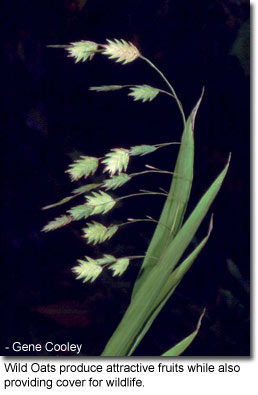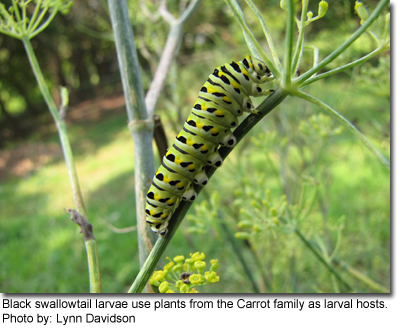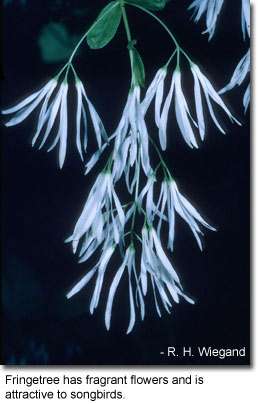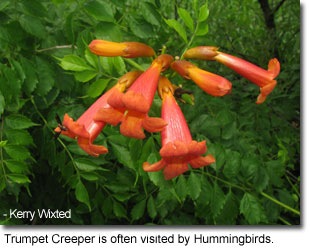Wild-scaping Townhouses & Condominiums
Backyard wildlife habitat does not have to be restricted to acres and acres of well-landscaped yards. This article is designed to give you ideas on how to turn your townhouse or condominium backyard into a wildlife garden with helpful tips on how to arrange food, water and shelter elements of habitat for wildlife. Once you've planned your wildlife garden, make sure your wildscape complies with townhouse and condominium guidelines before planting. Songbirds, hummingbirds, butterflies, bees, moths, squirrels, chipmunks, turtles and rabbits are just some of the wildlife species that will visit a townhouse or condominium wildscape.
Always be sure of the light, soil and watering requirements of each plant and whether or not those needs will be met in the place it will be planted. Plant nurseries and garden centers are good sources for plant care information. Use organic solutions to insect and disease problems instead of pesticides whenever possible.
Diversity is the Key
Most townhouse yards are comprised of grass with very little landscaping. The key to creating excellent wildlife habitat, regardless of the total size of the yard, is to offer a diverse habitat. Small trees and shrubs should form the "backbone" of the garden with lower growing annuals and perennials planted in front. Create a diversity of vertical habitat by planting groundcovers and arbors in addition to trees, shrubs and flowers. These plants form layers of habitat that are attractive to a greater number of wildlife species than if you just planted grass and trees. Also, select plants that do "double duty" in the wildlife garden by serving as food and shelter, which is especially important where space is limited.
How much grass should you keep? If you have children or pets, then some grass is necessary. A general rule of thumb is to have 60% or more of your yard area (excluding the house) planted in something other than grass. This rule is for the person who wants to retire their mower completely and incorporates a diverse blending of shrubs, annuals, perennials and vines in an arrangement that makes good use of available vertical space. Other vertical components adding dimension to the design include window boxes and a grape vine.
Habitat Elements
Food
Trees, shrubs and flowers represent important food components in the wildlife garden. Plants provide food in the fruit they produce, including seeds, berries, or nuts, or serve as food themselves. Plants should be chosen so that a variety of plants flower and fruit all season, which ensures a natural food supply will always be available to wildlife. Also, keep in mind the fruiting characteristics of plants. Inkberries and yews are dioecious, meaning that male and female flowers are on separate plants. If berries are desired as a food component than a male and female must be planted near each other. It's also imperative to prune these shrubs carefully and at the proper time of year to make sure you don't severely prune off your future food supply.
Annuals and perennials are excellent sources of nectar for hummingbirds, butterflies, bees and moths. After flowering, some annuals and perennials produce seeds that are enjoyed by songbirds. Be sure to select flower varieties that produce single rather than double flowers because singles are richer sources of nectar. Annuals, as a general rule, flower for a longer period than perennials and can provide vivid colors. Perennials should be chosen so that something is flowering throughout the season. Some of the best bee and butterfly plants are herbs, which when planted, can also add to your kitchen creations.
Water
Fresh water is probably the most important habitat element that you can add to your wildlife garden. There are many kinds of pedestal birdbaths commercially available. A ground birdbath placed in the garden with a circulating pump and mister may attract shy warblers and is a good choice for yards that aren't accessible to free-roaming predators (like cats). A shallow saucer or dish filled with fresh water does just as well. There are also birdbaths commercially available that can attach directly to porch and deck railings that are just as useful for birds to drink and bathe. A saucer filled with sand and kept wet provides water and nutrients for butterflies and toads too!
Shelter
Evergreen trees and shrubs and bushy or thorny deciduous shrubs can provide shelter for wildlife, even when planted next to the house in a foundation bed. Depending on the shrub, birds may even nest in it. Wildlife need shelter from the weather and safe places to rest and nest away from predators. Planting evergreens near feeders can provide year-round shelter for birds.
A grape arbor provides a nice shady retreat for both you and wildlife. In addition to these plant components, bird nesting boxes also provide important shelter for many wildlife species to raise their young. Roosting boxes provide safe places for resting and protection from the elements. If you have a shady spot with some space, then consider adding a
 toad abode to the landscape.
toad abode to the landscape.
Recommended Plant List
The following list provides some recommendations for wildlife friendly plants. When selecting plants, keep in mind the size of your space as well as soil and light requirements for the plants you install. Also, be an informed consumer and stay away from plants that are known to be invasive. For a list of commonly planted invasive species, check out the “Bad Plants Planted by Good People” page.

Annuals
Species |
Native? |
Flower/Fruit |
Benefits |
Cosmos | N | Jun-Aug | Attractive to bees and butterflies |
Flowering Tobacco (Nicotiana alata) | N | May-Jul | Attractive to bees, butterflies and birds. |
Hollyhocks (Alcea spp.) | N | | Attractive to bees and butterflies; biennial |
Pentas (Pentas spp.) | N | Jun-Sept | Nectar attracts bees, butterflies, birds |
Petunia (Petunia spp.) | N | Apr-Jul | Can attract butterflies like Painted ladies |
Salvia (Salvia spp.) | N | May-Sep | Great for beneficial insect pollinators |
Sunflowers (Helianthus annuus) | N | Jun-Aug | Attracts butterflies, bees, beneficial insects, birds and small mammals |
Sweet William/Phlox (Phlox divaricata) | Y | Apr-Jun | Showy spring flower that attracts butterflies |
Sweet William (Dianthus barbatus) | N | Jun-Jul | Attracts butterflies and hummingbirds |
Zinnia | N | | Pentas are favorites of bees and butterflies |

Grasses
Species |
Native? |
Flower/Fruit |
Benefits |
Big Bluestem (Andropogon gerardii) | Y | Jun-Sep | Clump forming plant which provides cover |
Eastern Gamagrass (Tripsacum dactyloides | Y | Jun-Oct | Clump forming plant which provides cover and seeds for wildlife |
Indiangrass (Sorghastrum nutans) | Y | Aug-Oct | Clump forming plant which provides cover |
Little bluestem
(Schizachyrium scoparium | Y | Aug-Oct | Clump forming plant which provides cover and seeds for wildlife |
Switchgrass
(Panicum virgatum) | Y | Jul-Oct | Clump forming plant which provides food for sparrows and other songbirds |
Wild Oats (Chasmanthium latifolium) | Y | Jul-Sep | Provides cover |

Herbs*
Species |
Native? |
Flower/Fruit |
Benefits |
Dill (Anethum graveolens) | N | | Host for Black swallowtail larvae |
Fennel (Foeniculum vulgare) | N | | Host for Black swallowtail larvae |
Rosemary (Rosemaryinus officinalis) | N | | Good for bees |
Sweet Marjoram (Origanum vulgare) | N | | Good for bees |
Thyme (Thymus) | N | | Excellent for bees |
* Note: many herbs can be aggressive in the garden, so it is best to plant them in containers

Perennials
Species |
Native? |
Flower/Fruit |
Benefits |
Beebalm (Monarda didyma) | Y | Jul-Sep | Showy, aromatic flowers which attract hummingbirds and butterflies |
Beardtongue (Penstemon digitalis) | Y | Jun-Aug | Great for hummingbirds |
Black-eyed Susan (Rudbeckia hirta) | Y | Jun-Oct | Provides both a pollen and nectar source for wildlife |
Blazingstar (Liatris spicata) | Y | Jul-Aug | Nectar source for butterflies and beneficial insect; grows in dry soil |
Butterflyweed (Asclepias tuberosa) | Y | May-Jul/ Aug-Nov | Host plant for monarch butterflies. Also attracts adult butterflies |
Common Milkweed (Asclepias syriaca) | Y | May-Jun/ Aug-Nov | Host plant for butterflies; fragrant and attracts beneficial insects |
Ironweed (Vernonia noveboracensis) | Y | Aug-Oct | Host plant for butterflies |
Joe Pyeweed (Eupatorium fistulosum) | Y | Jul-Oct | Attracts songbirds, butterflies and beneficial insects; great for rain gardens |
Larkspurs (Delphinium spp). | Y/N | Apr-Jun | Provides nectar for butterflies and beneficial insects |
Partridgeberry (Mitchella repens) | Y | May-Jul/ Jul-Dec | Groundcover that provides berries for birds and small mammals |
Purple Coneflower (Echinacea purpureum) | Y | Jul-Aug | Provides nectar for pollinators as well as seeds for birds |
Stonecrops (Sedum spp.) | Y/N | | Provides good groundcover and some varieties are used by butterflies |
Wild Columbine (Aquilegia canadensis) | Y | Apr-Jul | Great for butterflies, hummingbirds and beneficial insects |

Shrubs
Species |
Native? |
Flower/Fruit |
Benefits |
Blueberries (Vaccinium spp.) | Y/N | | Provide berry source for birds as well as nectar source for butterflies and bees |
Coralberry
(Symphoricarpos orbiculatus) | Y | Apr-Jun | Provides cover, nectar for insects, berries for songbirds and leaves for moths |
Dogwoods (Cornus spp.) | Y/N | | Provides cover and berries for birds and small mammals |
Elderberry (Sambucus canadensis) | Y | May Jun-Jul | Fragrant flowers and berries important for songbirds and small mammals |
Hydrangea (Hydrangea spp.) | Y/N | Jun-Aug | Provides cover and food for pollinators |
Inkberry (Ilex glabra) | Y | May-Jun/ Sep-Mar | Provides cover and berries for songbirds and small mammals; need a male and female for berries |
Juniper (dwarf varieties) | N | | Provides year-round shelter |
Rhododendron (Rhododendron maximum) | Y | May-Aug Sep-Nov | Provides year-round shelter for wildlife |
Virginia Sweetspire (Itea virginica) | Y | Jun-Jul/ Aug-Mar | Provides nectar for beneficial insects and fruit for songbirds and small mammals |
Winterberry (Ilex verticillata) | Y | Jun-Jul/ Aug-Feb | Provides cover and berries for songbirds and small mammals; need a male and female for berries |
Yew (Taxus canadensis) | Y | Mar-May/ Jul-Sep | Provides cover and berries for songbirds |

Small Trees
Species |
Native? |
Flower/Fruit |
Benefits |
American holly (Ilex opaca) | Y | May-Jun | Provides year-round cover and berries for songbirds |
Fire Cherry (Prunus pensylvanica) | Y | May/ Jul-Sep | High wildlife value for birds and mammals |
Fringetree (Chionanthus virginicus) | Y | May-Jun/ Sep-Oct | Fragrant flowers and attractive to songbirds |
Mountain Ash (Sorbus americana) | Y | May-Jul/ Aug-Dec | High wildlife value for songbirds and small mammals |
Paw-paw (Asimina triloba) | Y | Apr-Jun/ Aug-Sep | Produces edible fruits favored by birds, mammals and people |
Serviceberry (Amelanchier arborea) | Y | Mar-May/ May-Jun | Used by 58 species of wildlife in MD; berries are edible to songbirds, mammals and people |

Vines
Species |
Native? |
Flower/Fruit |
Benefits |
Bittersweet (Celastrus scandens) | Y | May-Jun/ Sept-Dec | Provides fruits, buds and leaves. Excellent winter food for birds. Oriental bittersweet (C. orbiculatus) is invasive. |
Passionflower (Passiflora incarnata) | Y | Jun-Sep/ Sep-Oct | Great for butterflies and provides edible fruits |
Trumpet Creeper (Campsis radicans) | Y | Jul-Sep/ Aug-Mar | Great for butterflies and hummingbirds |
Trumpet Honeysuckle (Lonicera sempervirens) | Y | Apr-Oct/ Aug-Mar | Excellent plant for hummingbirds and provides berries for songbirds |
Virgin’s Bower (Clematis virginiana) | Y | Jul-Sept/ Aug-Nov | Fragrant flowers |
Wild Grape (Vitis spp.) | Y/N | | Provides berries for wildlife |
Acknowledgements:
- Wild Oats photo by Gene Cooley
- Black swallowtail caterpillar photo by Lynn Davidson
- Fringetree photo by R. H. Wiegand
- All other photos by Kerry Wixted
Click here for a PDF version of this webpage for printing or reading purposes.
For Additional Information, Please Contact:
Sarah B. Witcher
410-260-8566
sarah.witcher1@maryland.gov
Department of Natural Resources
Wildlife and Heritage Service
580 Taylor Avenue, E-1
Annapolis, Maryland 21401
Sarah B. Witcher
410-260-8566
sarah.witcher1@maryland.gov
Department of Natural Resources
Wildlife and Heritage Service
580 Taylor Avenue, E-1
Annapolis, Maryland 21401